Majid Zamani
Technical University of Munich, Munich, Germany
A Real-time and Hardware Efficient Artfecat-free Spike Sorting Using Deep Spike Detection
Apr 19, 2025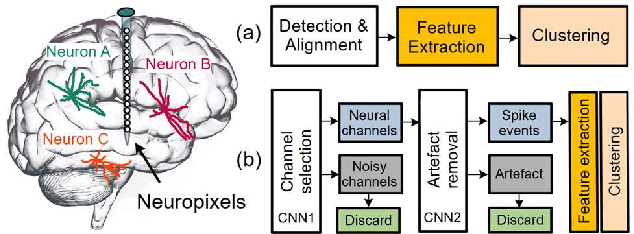
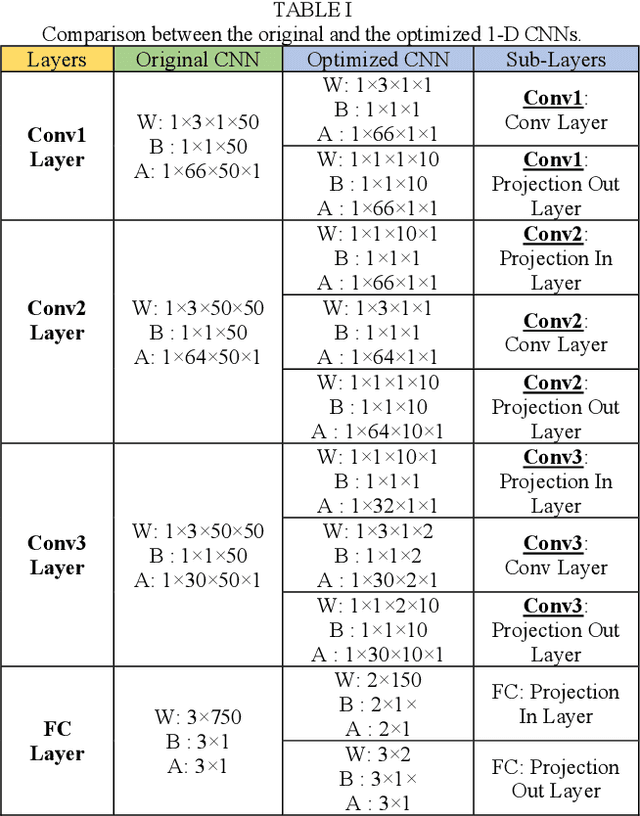


Abstract:Spike sorting is a valuable tool in understanding brain regions. It assigns detected spike waveforms to their origins, helping to research the mechanism of the human brain and the development of implantable brain-machine interfaces (iBMIs). The presence of noise and artefacts will adversely affect the efficacy of spike sorting. This paper proposes a framework for low-cost and real-time implementation of deep spike detection, which consists of two one-dimensional (1-D) convolutional neural network (CNN) model for channel selection and artefact removal. The framework utilizes simulation and hardware layers, and it applies several low-power techniques to optimise the implementation cost of a 1-D CNN model. A compact CNN model with 210 bytes memory size is achieved using structured pruning, network projection and quantization in the simulation layer. The hardware layer also accommodates various techniques including a customized multiply-accumulate (MAC) engine, novel fused layers in the convolution pipeline and proposing flexible resource allocation for a power-efficient and low-delay design. The optimized 1-D CNN significantly decreases both computational complexity and model size, with only a minimal reduction in accuracy. Classification of 1-D CNN on the Cyclone V 5CSEMA5F31C6 FPGA evaluation platform is accomplished in just 16.8 microseconds at a frequency of 2.5 MHz. The FPGA prototype achieves an accuracy rate of 97.14% on a standard dataset and operates with a power consumption of 2.67mW from a supply voltage of 1.1 volts. An accuracy of 95.05% is achieved with a power of 5.6mW when deep spike detection is implemented using two optimized 1-D CNNs on an FPGA board.
Data-Driven Safety Verification using Barrier Certificates and Matrix Zonotopes
Apr 01, 2025Abstract:Ensuring safety in cyber-physical systems (CPSs) is a critical challenge, especially when system models are difficult to obtain or cannot be fully trusted due to uncertainty, modeling errors, or environmental disturbances. Traditional model-based approaches rely on precise system dynamics, which may not be available in real-world scenarios. To address this, we propose a data-driven safety verification framework that leverages matrix zonotopes and barrier certificates to verify system safety directly from noisy data. Instead of trusting a single unreliable model, we construct a set of models that capture all possible system dynamics that align with the observed data, ensuring that the true system model is always contained within this set. This model set is compactly represented using matrix zonotopes, enabling efficient computation and propagation of uncertainty. By integrating this representation into a barrier certificate framework, we establish rigorous safety guarantees without requiring an explicit system model. Numerical experiments demonstrate the effectiveness of our approach in verifying safety for dynamical systems with unknown models, showcasing its potential for real-world CPS applications.
Transfer Learning for Control Systems via Neural Simulation Relations
Dec 02, 2024



Abstract:Transfer learning is an umbrella term for machine learning approaches that leverage knowledge gained from solving one problem (the source domain) to improve speed, efficiency, and data requirements in solving a different but related problem (the target domain). The performance of the transferred model in the target domain is typically measured via some notion of loss function in the target domain. This paper focuses on effectively transferring control logic from a source control system to a target control system while providing approximately similar behavioral guarantees in both domains. However, in the absence of a complete characterization of behavioral specifications, this problem cannot be captured in terms of loss functions. To overcome this challenge, we use (approximate) simulation relations to characterize observational equivalence between the behaviors of two systems. Simulation relations ensure that the outputs of both systems, equipped with their corresponding controllers, remain close to each other over time, and their closeness can be quantified {\it a priori}. By parameterizing simulation relations with neural networks, we introduce the notion of \emph{neural simulation relations}, which provides a data-driven approach to transfer any synthesized controller, regardless of the specification of interest, along with its proof of correctness. Compared with prior approaches, our method eliminates the need for a closed-loop mathematical model and specific requirements for both the source and target systems. We also introduce validity conditions that, when satisfied, guarantee the closeness of the outputs of two systems equipped with their corresponding controllers, thus eliminating the need for post-facto verification. We demonstrate the effectiveness of our approach through case studies involving a vehicle and a double inverted pendulum.
Transfer of Safety Controllers Through Learning Deep Inverse Dynamics Model
May 22, 2024



Abstract:Control barrier certificates have proven effective in formally guaranteeing the safety of the control systems. However, designing a control barrier certificate is a time-consuming and computationally expensive endeavor that requires expert input in the form of domain knowledge and mathematical maturity. Additionally, when a system undergoes slight changes, the new controller and its correctness certificate need to be recomputed, incurring similar computational challenges as those faced during the design of the original controller. Prior approaches have utilized transfer learning to transfer safety guarantees in the form of a barrier certificate while maintaining the control invariant. Unfortunately, in practical settings, the source and the target environments often deviate substantially in their control inputs, rendering the aforementioned approach impractical. To address this challenge, we propose integrating \emph{inverse dynamics} -- a neural network that suggests required action given a desired successor state -- of the target system with the barrier certificate of the source system to provide formal proof of safety. In addition, we propose a validity condition that, when met, guarantees correctness of the controller. We demonstrate the effectiveness of our approach through three case studies.
Efficient Approximation of Action Potentials with High-Order Shape Preservation in Unsupervised Spike Sorting
Apr 28, 2022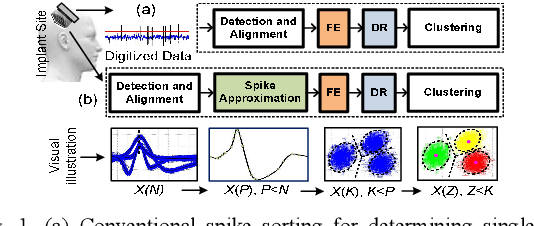


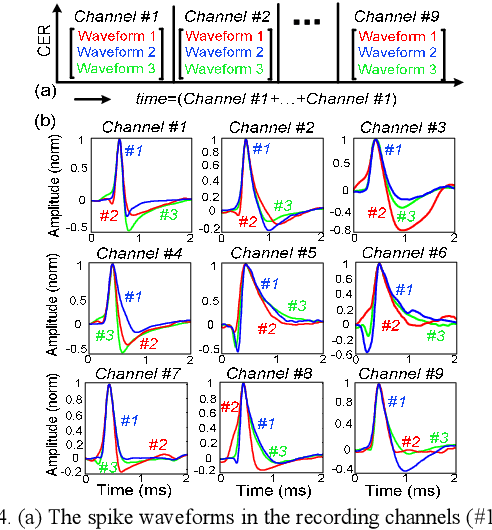
Abstract:This paper presents a novel approximation unit added to the conventional spike processing chain which provides an appreciable reduction of complexity of the high-hardware cost feature extractors. The use of the Taylor polynomial is proposed and modelled employing its cascaded derivatives to non-uniformly capture the essential samples in each spike for reliable feature extraction and sorting. Inclusion of the approximation unit can provide 3X compression (i.e. from 66 to 22 samples) to the spike waveforms while preserving their shapes. Detailed spike waveform sequences based on in-vivo measurements have been generated using a customized neural simulator for performance assessment of the approximation unit tested on six published feature extractors. For noise levels {\sigma}_N between 0.05 and 0.3 and groups of 3 spikes in each channel, all the feature extractors provide almost same sorting performance before and after approximation. The overall implementation cost when including the approximation unit and feature extraction shows a large reduction (i.e. up to 8.7X) in the hardware costly and more accurate feature extractors, offering a substantial improvement in feature extraction design.
Control Barrier Functions for Unknown Nonlinear Systems using Gaussian Processes
Oct 12, 2020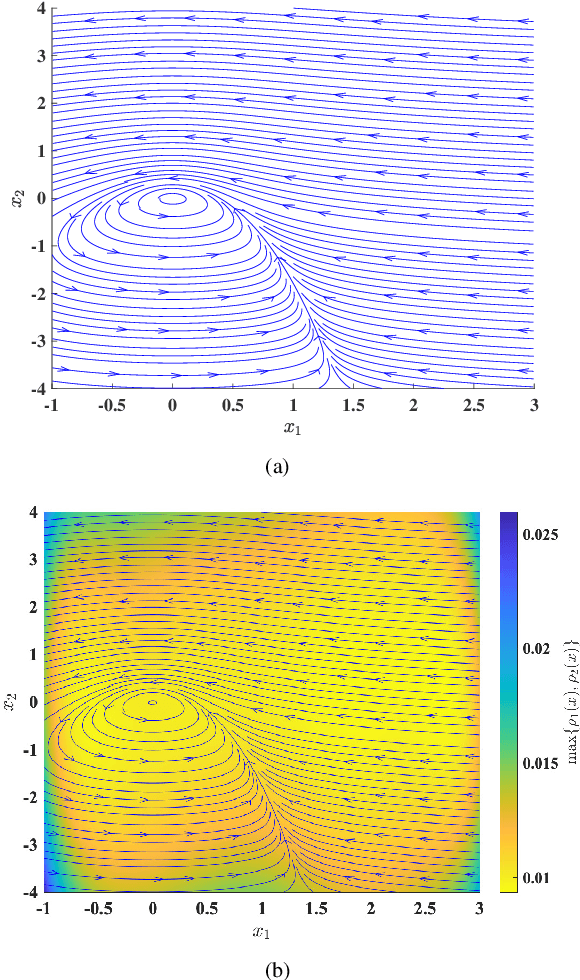
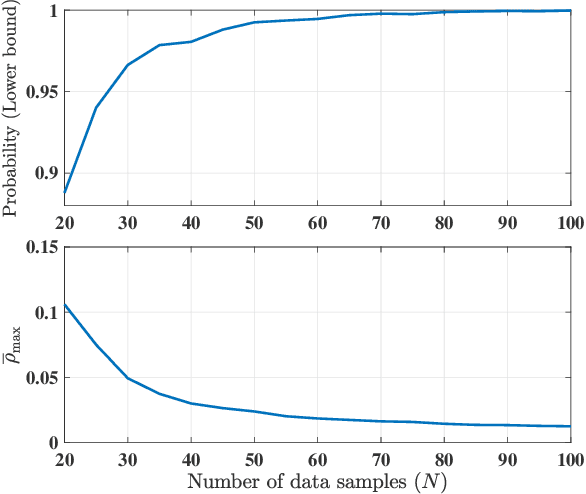
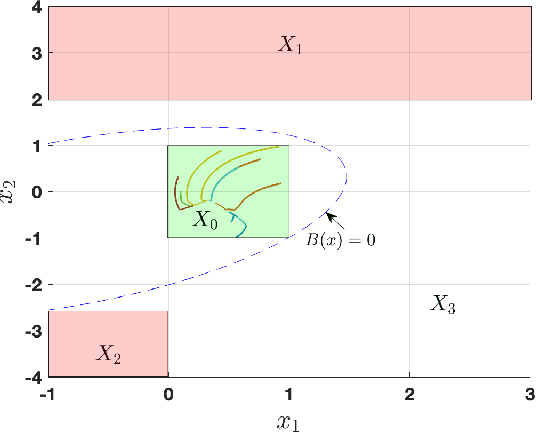
Abstract:This paper focuses on the controller synthesis for unknown, nonlinear systems while ensuring safety constraints. Our approach consists of two steps, a learning step that uses Gaussian processes and a controller synthesis step that is based on control barrier functions. In the learning step, we use a data-driven approach utilizing Gaussian processes to learn the unknown control affine nonlinear dynamics together with a statistical bound on the accuracy of the learned model. In the second controller synthesis steps, we develop a systematic approach to compute control barrier functions that explicitly take into consideration the uncertainty of the learned model. The control barrier function not only results in a safe controller by construction but also provides a rigorous lower bound on the probability of satisfaction of the safety specification. Finally, we illustrate the effectiveness of the proposed results by synthesizing a safety controller for a jet engine example.
Data-Driven Verification under Signal Temporal Logic Constraints
May 08, 2020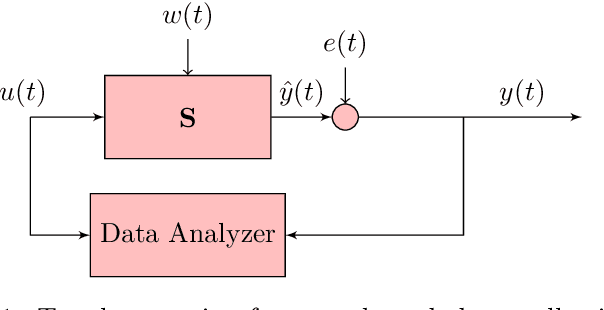
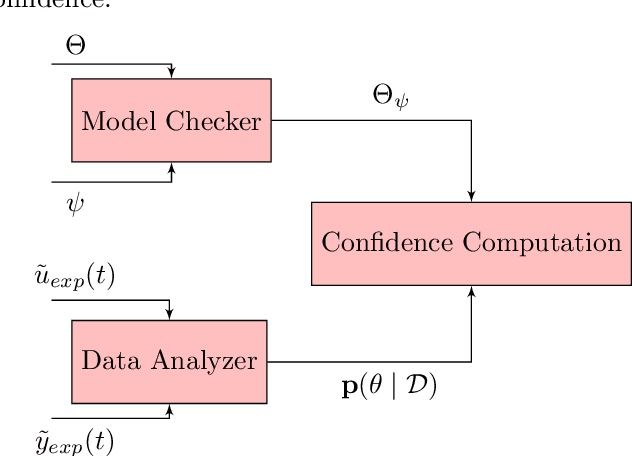
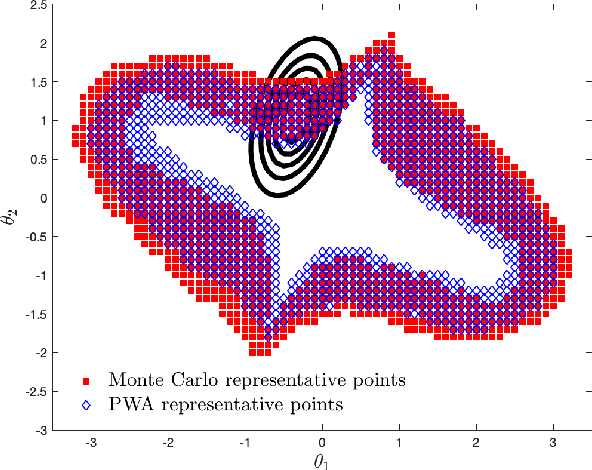
Abstract:We consider systems under uncertainty whose dynamics are partially unknown. Our aim is to study satisfaction of temporal logic properties by trajectories of such systems. We express these properties as signal temporal logic formulas and check if the probability of satisfying the property is at least a given threshold. Since the dynamics are parameterized and partially unknown, we collect data from the system and employ Bayesian inference techniques to associate a confidence value to the satisfaction of the property. The main novelty of our approach is to combine both data-driven and model-based techniques in order to have a two-layer probabilistic reasoning over the behavior of the system: one layer is related to the stochastic noise inside the system and the next layer is related to the noisy data collected from the system. We provide approximate algorithms for computing the confidence for linear dynamical systems.
Formal Controller Synthesis for Continuous-Space MDPs via Model-Free Reinforcement Learning
Mar 02, 2020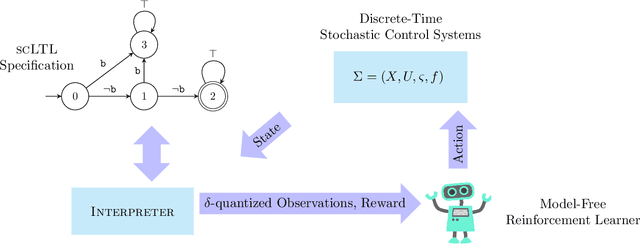
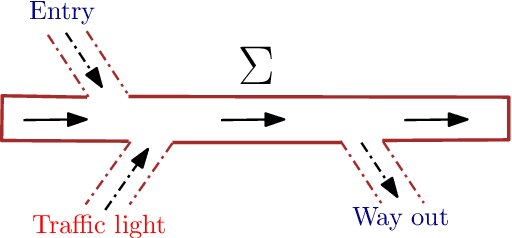
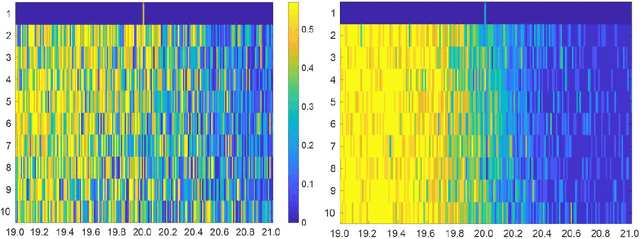

Abstract:A novel reinforcement learning scheme to synthesize policies for continuous-space Markov decision processes (MDPs) is proposed. This scheme enables one to apply model-free, off-the-shelf reinforcement learning algorithms for finite MDPs to compute optimal strategies for the corresponding continuous-space MDPs without explicitly constructing the finite-state abstraction. The proposed approach is based on abstracting the system with a finite MDP (without constructing it explicitly) with unknown transition probabilities, synthesizing strategies over the abstract MDP, and then mapping the results back over the concrete continuous-space MDP with approximate optimality guarantees. The properties of interest for the system belong to a fragment of linear temporal logic, known as syntactically co-safe linear temporal logic (scLTL), and the synthesis requirement is to maximize the probability of satisfaction within a given bounded time horizon. A key contribution of the paper is to leverage the classical convergence results for reinforcement learning on finite MDPs and provide control strategies maximizing the probability of satisfaction over unknown, continuous-space MDPs while providing probabilistic closeness guarantees. Automata-based reward functions are often sparse; we present a novel potential-based reward shaping technique to produce dense rewards to speed up learning. The effectiveness of the proposed approach is demonstrated by applying it to three physical benchmarks concerning the regulation of a room's temperature, control of a road traffic cell, and of a 7-dimensional nonlinear model of a BMW 320i car.
dtControl: Decision Tree Learning Algorithms for Controller Representation
Feb 12, 2020
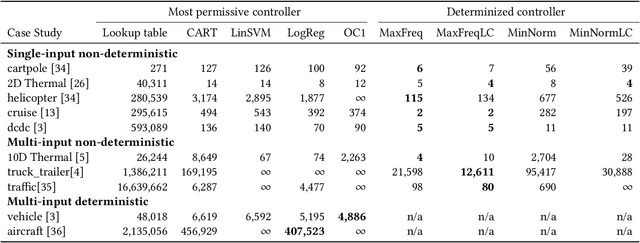

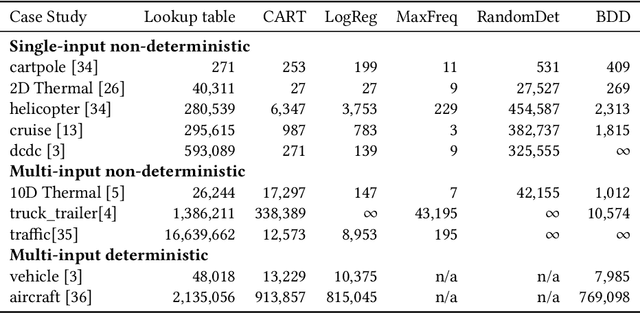
Abstract:Decision tree learning is a popular classification technique most commonly used in machine learning applications. Recent work has shown that decision trees can be used to represent provably-correct controllers concisely. Compared to representations using lookup tables or binary decision diagrams, decision trees are smaller and more explainable. We present dtControl, an easily extensible tool for representing memoryless controllers as decision trees. We give a comprehensive evaluation of various decision tree learning algorithms applied to 10 case studies arising out of correct-by-construction controller synthesis. These algorithms include two new techniques, one for using arbitrary linear binary classifiers in the decision tree learning, and one novel approach for determinizing controllers during the decision tree construction. In particular the latter turns out to be extremely efficient, yielding decision trees with a single-digit number of decision nodes on 5 of the case studies.
SENSE: Abstraction-Based Synthesis of Networked Control Systems
Jun 26, 2018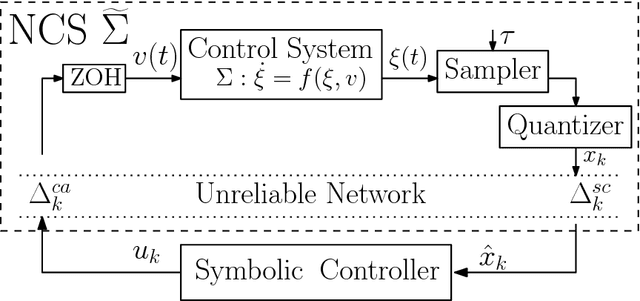
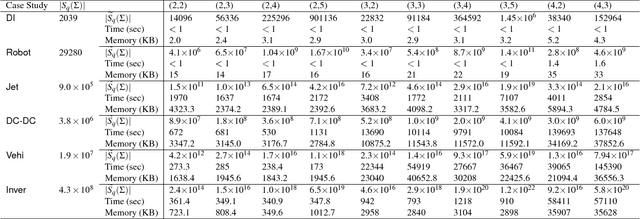
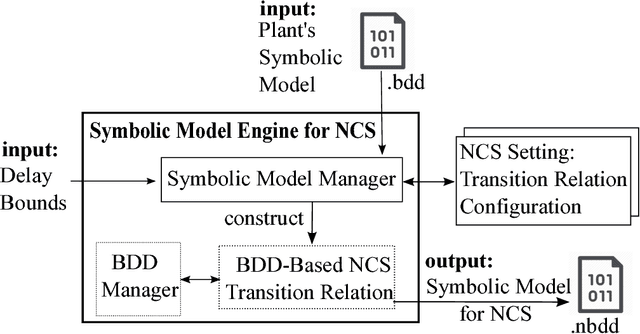
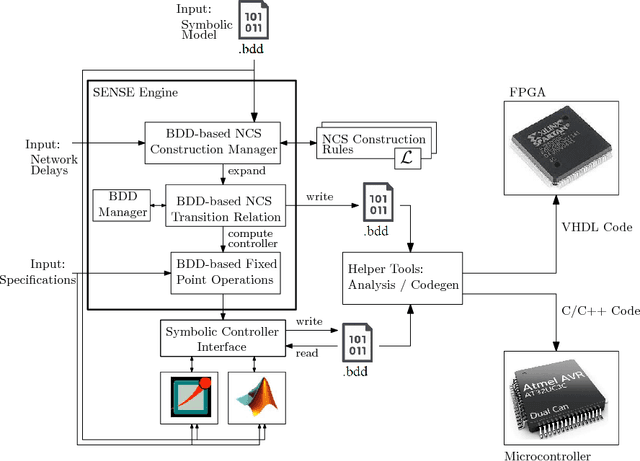
Abstract:While many studies and tools target the basic stabilizability problem of networked control systems (NCS), nowadays modern systems require more sophisticated objectives such as those expressed as formulae in linear temporal logic or as automata on infinite strings. One general technique to achieve this is based on so-called symbolic models, where complex systems are approximated by finite abstractions, and then, correct-by-construction controllers are automatically synthesized for them. We present tool SENSE for the construction of finite abstractions for NCS and the automated synthesis of controllers. Constructed controllers enforce complex specifications over plants in NCS by taking into account several non-idealities of the communication channels. Given a symbolic model of the plant and network parameters, SENSE can efficiently construct a symbolic model of the NCS, by employing operations on binary decision diagrams (BDDs). Then, it synthesizes symbolic controllers satisfying a class of specifications. It has interfaces for the simulation and the visualization of the resulting closed-loop systems using OMNETPP and MATLAB. Additionally, SENSE can generate ready-to-implement VHDL/Verilog or C/C++ codes from the synthesized controllers.
* In Proceedings MeTRiD 2018, arXiv:1806.09330
 Add to Chrome
Add to Chrome Add to Firefox
Add to Firefox Add to Edge
Add to Edge